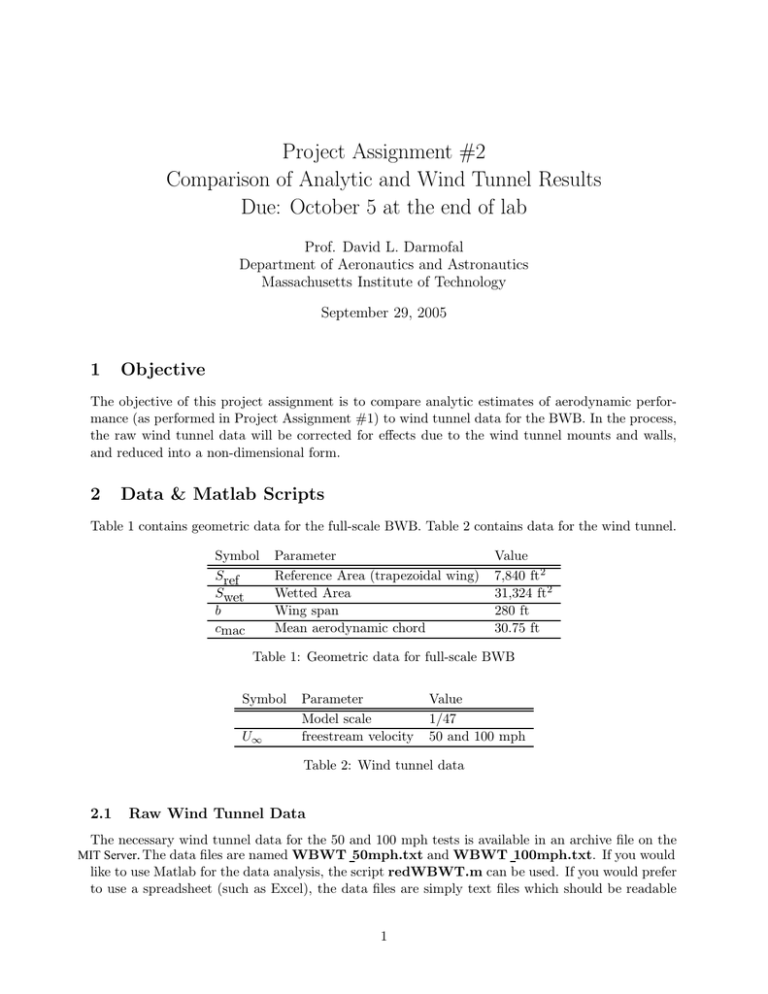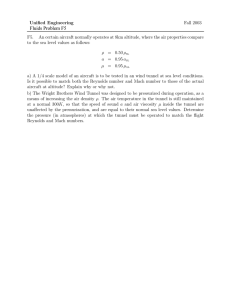Project Assignment #2 Comparison of Analytic and Wind Tunnel Results
advertisement

Project Assignment #2 Comparison of Analytic and Wind Tunnel Results Due: October 5 at the end of lab Prof. David L. Darmofal Department of Aeronautics and Astronautics Massachusetts Institute of Technology September 29, 2005 1 Objective The objective of this project assignment is to compare analytic estimates of aerodynamic perfor­ mance (as performed in Project Assignment #1) to wind tunnel data for the BWB. In the process, the raw wind tunnel data will be corrected for effects due to the wind tunnel mounts and walls, and reduced into a non-dimensional form. 2 Data & Matlab Scripts Table 1 contains geometric data for the full-scale BWB. Table 2 contains data for the wind tunnel. Symbol Sref Swet b cmac Parameter Reference Area (trapezoidal wing) Wetted Area Wing span Mean aerodynamic chord Value 7,840 ft 2 31,324 ft2 280 ft 30.75 ft Table 1: Geometric data for full-scale BWB Symbol U� Parameter Model scale freestream velocity Value 1/47 50 and 100 mph Table 2: Wind tunnel data 2.1 Raw Wind Tunnel Data The necessary wind tunnel data for the 50 and 100 mph tests is available in an archive file on the MIT Server. The data files are named WBWT 50mph.txt and WBWT 100mph.txt. If you would like to use Matlab for the data analysis, the script redWBWT.m can be used. If you would prefer to use a spreadsheet (such as Excel), the data files are simply text files which should be readable 1 by any spreadsheet software. Each line in the data file represents an average taken over one second of the conditions, forces, and moments that occurred during the specific wind tunnel tests. Since the sample rate for the measurement devices is approximately 1000 cycles/second, each line of data is an average of approximately 1000 samples. The columns in the data files give different pieces of information. In particular, for this project assignment, you will need: • Mach number (M� ): column 3, • Angle of attack (�� ): column 6, (degrees), • Static pressure (p� ): column 10 (lbs/ft2 ), • Lift measurement voltage (Lv ): column 12 (volts), • Drag measurement voltage (Dv ): column 13 (volts), • Pitching moment measurement voltage (M v ): column 15 (volts). Conversion factors from force and moment voltage measurements to the actual forces and moment are given in Table 3. Lift Drag Moment 55.87 lbs/volt 8.93 lbs/volt 17.73 ft lbs/volt Table 3: Wind tunnel voltage conversions 2.2 Aerodynamic Model from Project Assignment #1 The aerodynamic analysis performed in the first project assignment (using AVL in combination with skin friction and pressure drag estimate) is also available in the Matlab script plotAVL.m. This script takes the AVL results as an input, adds on the skin friction and pressure drag estimates, and plots the results. 2.3 Choosing 50 or 100 mph in Matlab Scripts When using the provided Matlab scripts, the variable flag50mph needs to be set. If flag50mph = 1, then the data for the 50 mph conditions will be used. Otherwise, the data for the 100 mph conditions will be used. 3 3.1 Required Tasks Corrections for Wind Tunnel Mounts The force and moment measurements taken in the wind tunnel include the effects of the various mount devices attached to the BWB model. These attachments will in particular increase the measured drag above the drag produced by the BWB. In this task, you must estimate the drag contributions due to: 2 • Cylindrical mount: the exposed height of this mount is 0.41 feet and the width is 0.115 feet. While the mount actually is faceted (i.e. it has a polygonal cross-section), assume that the drag it creates can be estimated as that of a turbulent cylinder flow (the role of the faceted surface is to ensure that the flow on the mount is turbulent and will remain attached longer thereby reducing the pressure drag). • Pitch adjustment rod: this rod has an elliptical cross-section with a length of 0.0656 feet and a width of 0.0328 feet. The exposed height of the rod is 2.92 feet. To determine the drag on the rod, you can use drag coefficient data from Hoerner’s book on fluid dynamic drag [1]. • Flat plate sting: this sting is thin and aligned down the axis of the tunnel. The height of sting is 2 inches and the length is 1.5 feet. Briefly but completely describe how you estimated the three drag contributions. 3.2 Corrections for Wind Tunnel Walls A hand-out will be distributed in the lab sections describing how to correct the wind tunnel data for the presence of the wind tunnel walls. This correction must be made and briefly described in the write-up. Note, the cross-section of the Wright-Brothers Wind Tunnel test section is elliptical with a height of 7 feet and a width of 10 feet. 3.3 Comparison of Drag Corrections For the four drag corrections above (the mount, rod, sting, and wall corrections), quantify the relative magnitudes of these corrections with respect to each other as well as the drag on the BWB itself (i.e. are the corrections small relative to the BWB drag and/or each other)? 3.4 Form Factor At low angles of attack, the skin friction drag estimate can be (and usually is) adjusted by a form factor, specifically, Swet CDf = Kf orm cf . Sref The form factor, Kf orm , is supposed to be an adjustment to account for the errors in using flat plate skin friction estimates for bodies which are not flat. In reality, it is just a fudge factor. Once a form factor is determined (usually relying upon experimental results) for a particular aircraft geometry, then the hope is that this form factor will remain accurate for small changes to the geometry or operating conditions. The Matlab script, plotAVL.m, contains the form factor and it is set to Kf orm = 1. Determine a value of Kf orm that will improve the agreement of C D at low CL between the experimental and model results. 3.5 Plots For all of the following plots, include both the 50 and 100 mph wind speeds and the wind tunnel and model data on a single graph. In other words, each plot will contain four sets of data. Also, for the wind tunnel data, leave the data as a scatter plot of points (one point for each line of data in the data files). This will give a sense of the uncertainty present in the experimental data. 1. The coefficient of lift, CL , versus angle of attack (in degrees) 3 2. CL versus the coefficient of drag, CD using Kf orm = 1 for the aerodynamic model. 3. CL versus the coefficient of drag, CD using value of Kf orm determined in Section 3.4. 4. The pitching moment coefficient about the aerodynamic center, C M ac versus CL . Note, in this plot, fix the location of the aerodynamic center as the aerodynamic center of the BWB at zero lift as estimated by the AVL results. Specifically, from the first assignment, AVL xac cmac = 2.7 at CL = 0. IMPORTANT NOTE: the wind tunnel data gives the moment at the cylindrical mount which attaches the BWB wind tunnel model to the force measurement system. This cylin­ drical mount is a distance of 21.375 inches from the nose of the model. 3.6 Questions The following questions ask you to describe the agreement between the wind tunnel and aerody­ namic model. Be a specific as possible when describing this. For example: for low angles of attack (i.e. low CL ), do the results agree? For high angles of attack (i.e. high C L ), do the results agree? Is there a dependence on the wind tunnel speed in the wind tunnel results which is not observed in the aerodynamic model (or vice-versa). 1. Describe the agreement (or lack therefore) between the wind tunnel and aerodynamic model for CL versus �� . 2. Describe the agreement (or lack therefore) between the wind tunnel and aerodynamic model for CL versus CD for both Kf orm = 1 and the improved value of Kf orm . 3. Describe the agreement (or lack therefore) between the wind tunnel and aerodynamic model for CM ac versus CL . References [1] S.F. Hoerner. Fluid Dynamic Drag. Hoerner Fluid Dynamics, 1965. 2nd ed. 4




